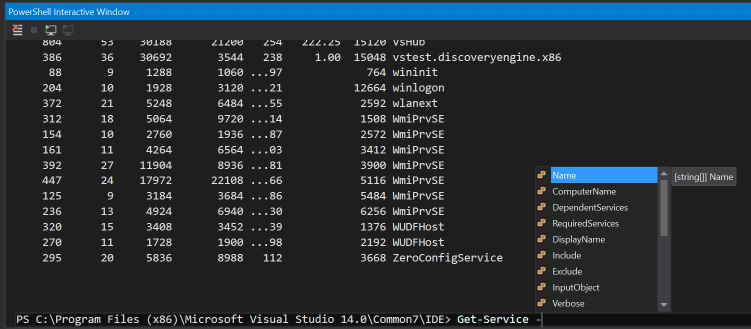

Task runner (configure to run Pester tests).Search and replace across multiple files.Open folder for editing (easily access multiple files).Here are a few reasons why you might want to consider using Visual Studio Code:
#POWERSHELL VISUAL STUDIO DARK THEME HOW TO#
Choose a PowerShell scripting environmentīefore diving into the details about how to get started with Visual Studio Code, it is worth mentioning why you might want to use Visual Studio Code beyond the obvious need for Linux or macOS support. Both projects have taken significant community contributions. The other project is vscode-powershell, which is a Visual Studio Code extension that integrates the PowerShell Editor Services. In this regard, PowerShell Editor Services is similar to OmniSharp, which provides C# language support to editors like Atom, Sublime, Vim, and Visual Studio Code. The PowerShell Editor Services project provides language and debug services for editors that want to support PowerShell script development beyond basic syntax colorization. To support cross-platform PowerShell script development, Microsoft started two new open-source projects. Did I mention that Visual Studio Code is also open source on GitHub? Detecting a trend here? To the surprise of many, Microsoft also open-sourced PowerShell. And, indeed, nine months later, Microsoft made PowerShell available cross-platform, supporting Linux and macOS in addition to Windows. NET, this was an important prerequisite before taking PowerShell cross-platform.
#POWERSHELL VISUAL STUDIO DARK THEME WINDOWS#
Since the PowerShell integrated scripting environment (ISE) shipped with Windows PowerShell 2.0 in 2009, the PowerShell landscape has changed significantly. Themes/blackboard.Summary: Learn about the features in Visual Studio Code that help you write PowerShell code. To use it, I just dot the script into my PowerShell ISE profile (see the $profile variable while in PowerShell ISE) like so (where. ScriptPaneBackgroundColor = '#FF2E3436' # tokens $psISE. CommandPaneBackgroundColor = '#FF2E3436' # script pane $psISE.

OutputPaneForegroundColor = '#FFFFFFFF' # command pane $psISE. OutputPaneTextBackgroundColor = '#FF2E3436' $psISE. OutputPaneBackgroundColor = '#FF2E3436' $psISE. # PowerShell ISE version of the VIM blackboard theme at # fonts $psISE.

Looks different, eh? Below is the code to get it to work: I’m particularly fond of the Options property off of $psISE. The $psISE variable offers up a wealth of options. Why did I need another editor? I didn’t get really excited until I saw all of the customizations that you can do with it. I use gVim to edit my scripts and have the console up all day. I’ll admit, when I heard about the graphical host, I thought it was nice but I really didn’t think I’d use it much. Here is a screenshot of it.Īs you can see, there are three panes included: one that allows you to edit PS1 scripts (with syntax highlighting and tab completion included), one that displays the output of your commands (whether from the script editor or the command pane), and one that allows you to type in commands (the equivalent of the prompt you get in the console host). The “ISE” in PowerShell ISE stands for Integrated Scripting Environment and is based on the upcoming WPF editor that will ship with Visual Studio 2010. Okay, so, it doesn’t actually ship with themes. I’ve got quite a bit I’d like to blog about regarding PowerShell, but I couldn’t wait to share one feature I love. And, of course, there was much rejoicing. Last week, the PowerShell team released PowerShell v2 CTP3.


 0 kommentar(er)
0 kommentar(er)
